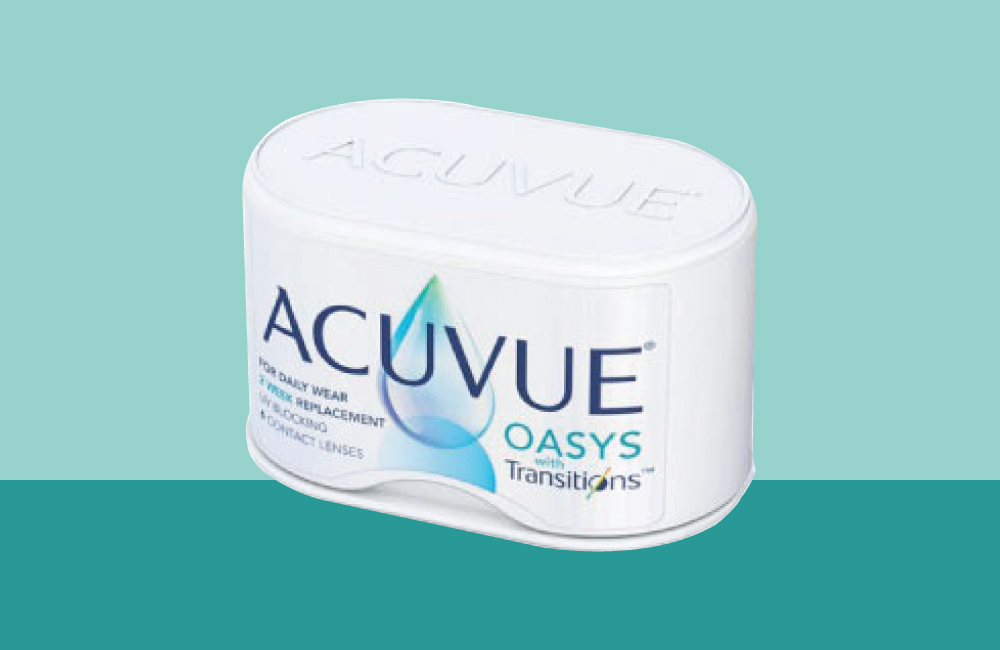Transition lenses are a new contact lens technology utilized by Acuvue Oasys with Transitions. These lenses contain the convenience of soft disposable contact lenses and the utility of UV protection by reducing the amount of light that enters the eyes when changing environments. Put simply, transitions contacts get “darker” when exposed to brighter light (i.e., sunlight) and remain “clear” when you are indoors.
These lenses can be a good option for patients who experience light sensitivity or headaches in bright lighting conditions. They continue to work both indoors and outdoors and are continually changing. They can also help with the glare when driving at night and enhance the contrast of colors up to 38%.
Acuvue Oasys with Transitions is also becoming popular with athletes who don’t want to wear goggles or glasses when exercising. It’s easy to understand why.
Another hidden benefit to these lenses is that they offer a small amount of protection against blue light. This is the only contact lens brand that touts this feature–which is heightened outdoors (15% blocking indoors, 55% blocking outdoors). This blue light protection has the potential to help with sleep cycles and cataract formation. Better sleep sounds nice.
How Do Transitions Contact Lenses Work?
Contact lenses with transitions technology darken within a minute when moving from dark to light conditions and then return to their clear state in about a minute and a half. They work indoors, outdoors, and at night. When the lenses are exposed to UV and high energy visible light, there is a change in the chemical bonds’ configuration–allowing for the darkening and filtering effect.
Care for these contacts are the same as you would handle any other pair of Acuvue Oasys bi-monthly contact lenses–replace them every 2 weeks and handle them as directed. This means no sleeping, showering, or swimming in the lenses and ensuring that they are only handled with clean, dry hands. Remember that contact lenses are medical devices and must be prescribed by your eye care provider.
If you want to go swimming, make sure you wear swimming goggles with your contacts.
Use Contacts Compare’s price tool to see which retailer has Acuvue Oasys with Transitions for the BEST price.
Are Transition Contact Lenses Worth It?
The decision if transition contact lenses are worth the money is entirely dependent on your use case. If you work outside, are very physically active, and don’t like to wear glasses or often forget to wear sunglasses, they could be the perfect alternative.
It’s important to know that transition contact lenses are not a replacement for sunglasses and the coverage only extends across the size of the contact lens. Sunglasses cover the entire eye and the delicate tissues surrounding the eyes. This means that besides the benefits of reducing the risks of UV exposure to the eye (cataracts, age-related macular degeneration), sunglasses also reduce the risk of sun damage to the skin.
Another potential disadvantage to the lenses is the aesthetic of the darkened lenses. They are 14 mm wide, meaning there will be a visible area of darkness across your eye. Some patients may find this effect unappealing, and some may not mind.
It is important to test these lenses out in real life so you can decide for yourself. Be sure to take careful note of how the lenses make your vision feel and how they make your eyes look. Due to the technology’s newness, these lenses are currently only available in spherical (non-astigmatism) powers from -12.00D to +8.00D.
Blue Light Protection Is A Plus, But There’s No Transitions Lens Available for Astigmatism Yet.
This means that patients with astigmatism or presbyopia (far-sightedness associated with aging) may not be able to get the clearest vision possible with these contacts.
This lens is the perfect option for patients who need the lenses for playing sports or outdoor activities. Also, patients seeking temporary freedom from sunglasses for short periods or patients who want increased color contrast or contact lenses with blue light blocking abilities will benefit from these lenses. It’s recommended that lenses are worn in both eyes, as wearing a transition contact lens in just one eye can lead to issues with judging depth and visual comfort. If one of your eyes has a low or no prescription, a plano (no power) transition contact lens should be placed in this eye.
You should also keep in mind that a good pair of polarized sunglasses is still your best line of defense to protect your eyes from the sun.
How Long Do Acuvue Oasys Transitions Last?
If you already wear bi-monthly Acuvue contact lenses, you’ll be able to wear the Acuvue Oasys Transition lenses with no problems. Acuvue is the only brand of contacts that offers ‘transitions’ technology. These lenses are both made from the same material and have the same water content.
Water content is simply the percentage of the contact lens that is water. In the case of the Acuvue Oasys Transitions, it is 38%. Though higher water content can make the lenses feel softer, patients suffering from dry eyes may feel more comfortable with low water contact lenses (like the Acuvue Transitions). While it sounds counter-intuitive, high water content lenses draw more tears to the eye, making them more susceptible to dryness.
Think about it this way: if the lens wants to remain at a high water content (to achieve homeostasis), it needs to acquire moisture from somewhere, so it draws on the tear film to do so. High water content may allow more oxygen transmission, but it comes at the cost of more likely causing dryness. Eye care providers often prescribe contact lenses at 38% rather than the higher water content lenses for dry eye patients.
Related: See the best contact lenses for dry eyes.
How Breathable Are Transitions Lenses?
The material the lenses are made of is called ‘silicone hydrogel.’ This is a soft, flexible plastic material that allows more oxygen to pass through the eye. This measure is called “oxygen transmission,” and the higher the number is, the more oxygen passes through the lenses into the eye. The cornea (the clear front structure of the eye) requires adequate oxygen supply; otherwise, new blood vessels can grow, disrupting your vision.
Other side effects of low oxygen transmission lenses are swelling of the cornea, changes in vision, and eye irritation.
These lenses need to be replaced every two weeks–just like other bi-weekly Acuvue Oasys lenses. While it isn’t clear if the lenses decrease in effectiveness after this period, there are more severe consequences with over-wearing lenses.
Any overwear of contact lenses puts you at higher risk for infections, inflammation, and redness of the eyes. It is also vital to never rinse your lenses using tap water. Always handle your contact lenses with clean, dry hands and store them in fresh multipurpose solution inside a clean contact lens case.
Where can I buy transition contact lenses?
Your best bet to get the lowest price is to buy online. After getting a valid prescription from an eye care provider, you can also purchase your transition lenses from them (if they sell them) or any legitimate online retailer. You can find out which of these online retailers has the best prices here.
How long should you wait before changing contacts?
As mentioned above, these contact lenses are good for 2 weeks and should be replaced at that interval. However, during the day, try not to wear your contact lenses for more than 8-10 hours at a time for maximum comfort. You can use contact lens rewetting drops if they ever get uncomfortable.
After you get home and no longer need your contacts, it is always a good idea to give your eyes a break by wearing your backup pair of glasses. That way, you can reduce the drying effects that occur with prolonged lens use.
As always, it’s essential to evaluate how the lenses feel on your eyes. If they ever feel irritated or appear red, make sure to remove and throw away the lenses and visit your eye care provider.

Dr. Morgan Jones is a Doctor of Optometry (O.D.) completing a residency in ocular disease. She has experience in diabetic research, along with several years of clinical research. Along with being a community outreach leader and an avid mentor and tutor, she enjoys educating outside of clinic. Dr. Jones has a B.A. in Biology from Texas A&M University.
